feature
Improving Writing Skills Through Scripting a Science Podcast for Non-Expert Audiences
Journal of College Science Teaching—July/August 2023 (Volume 52, Issue 6)
By Carolina Sotério and Salete Linhares Queiroz
In this article, we describe and analyze the experience of undergraduate chemistry students who scripted episodes of a science podcast for non-expert audiences. This practice aimed to improve public communication of science and technology, often suppressed throughout science careers but relevant for developing critical thinking. In particular, the script analysis focused on writing strategies used by students to promote suitability to the target audience. In this process, the students were responsible for searching for themes, scripting, and submitting episodes to a local radio station to record and broadcast. We compare feedback from students, experts, and listeners, showing an influence of current issues; a prevalence of interlocution, colloquialism, and apposition as language features; an awareness of using jargon; and a suitability to non-experts.
The word “podcasting,” derived by merging “pod” (from “iPod”) and “casting” (from “broadcasting”), is the act of distributing digital audio files (podcasts) to internet users for automatic download (Oxford Learner’s Dictionaries, 2005). Podcasting stands out from other media due to its intimate tone and the fact that it gives listeners the chance to multitask by listening while doing other activities, such as commuting, working, or doing chores (Lindgren, 2016).
Podcasts can reach different audiences by outlining a multiplicity of themes, formats, and distribution strategies. In the classroom, these media can help the teaching and learning process and familiarize faculty members and students with communication and information technologies (Goldman, 2018). Furthermore, given the COVID-19 pandemic and the pivot to remote learning, podcasts have been used as educational resources to distribute information online (Reimers & Schleicher, 2020). However, despite podcasts’ popularity, using them to assist classes is still a recent change. A survey carried out using publications in the Journal of College Science Teaching revealed that textual production is still one of the most used strategies in higher education to address science communication (Sotério et al., 2019).
Including the public communication of science and technology (PCST) in natural science classes helps train undergraduates by addressing not only language skills but also the development of critical thinking, notions of target audience, and the learning itself (Lancor & Schiebel, 2018; Tuten & Temesvari, 2013). Indeed, the communicator’s background and criticality contribute to minimizing misinformation in popular media (Murcott, 2009).
These skills are even more relevant considering the COVID-19 pandemic, in which science led the news in an unprecedented way. However, training undergraduates in science, technology, engineering, and mathematics (STEM) to communicate science to non-experts is still incipient. Thus, there is a global demand for developing communication, information literacy, and mastery of technologies and media as part of the desirable skills in science education for the 21st century (National Science Teaching Association, 2011).
Bearing this in mind, in this article, we aim to report on the scripting of podcasts in everyday chemistry and related fields by undergraduate chemistry students, members of a science outreach group based at the University of São Paulo; analyze the scripts to identify the writing strategies adopted by students to make scientific content suitable for non-experts; and compare the results with the perspectives of listeners and experts.
Materials and methods
The context
The Minuto da Química (Chemistry Minute) podcast seasons have been produced every 6 months since 2019 (with a special holiday edition) by undergraduate chemistry students who are members of the American Chemical Society University of São Paulo student chapter, with a focus on science outreach. Among the group’s projects, in addition to the one reported on in this article, there are social media posts, chemistry shows, workshops, and other products. The program has a “Did you know?” approach in spot format—that is, similar to a radio commercial—and addresses natural sciences and their relationship with everyday life to disseminate accurate information to non-experts. The episodes are broadcast weekly both on the local radio station’s (UFSCar radio 95.3 FM) schedule and online.
Collaborative scripting
The contract signed with the radio station took place with the support of the university’s press office, which offered podcast scripting training through a workshop during the first season. The scripting process, in turn, had the collaboration of 16 student-authors, three coordinators, two hosts, 10 experts, and two radio producers over the 5 seasons (Figure 1). It should be noted that each script was equivalent to one episode; students were free to contribute as many scripts as they wanted; and the student-host, in addition to being an author, contributed by reading out the texts.

Five stages of podcast production.
Each season, a student voluntarily assumed the role of coordinator, who was legally responsible for communicating with the radio station, managing the episodes, and training student-authors as new members joined the writing team (Stage I). Next, each student-author (individually or in pairs) researched topics about everyday chemistry and related fields that were of interest to them (Stage II). The first script version was then written by the student-authors and submitted to professors or graduate students for review; taking on the role of the experts, the professors or graduate students made constructive comments on both the format and content (Stage III). The scripts were then returned to the student-authors for the necessary corrections (Stage IV). Finally, this latest version was sent to the student-host and radio producers for recording, editing, and publishing the episodes on the radio schedule and online via the website and Spotify (Stage V).
Data collection and analysis
The scripts from the podcast’s 5 seasons (n = 65 episodes from August 2019 to July 2021) were analyzed in order to identify the writing strategies, according to the Popular Science Texts (PST) Analytical Framework, adapted from Ferreira and Queiroz (2011), to consider the particularities of an audio production (Figure 2). Indeed, both PST and podcast scripts are written forms of science communication aimed at nonspecialists, employing resources that enable suitability and capture the attention of the target audience. Moreover, a questionnaire containing a Likert-scale question and a checkbox question was used to understand student-authors’ perceptions about the challenges faced throughout the task.

Podcast script analytical framework.
Source. Framework based on Ferreira and Queiroz (2011).
Content
The first category, related to content analysis, was divided into two subcategories, general and specific. In general, the script’s theme can be classified into three subcategories: chemistry (contents that are formally addressed in teaching as a school subject), frontiers (areas that dialogue with chemistry, such as biology), or transversals (knowledge that permeates several subjects without necessarily belonging to a specific field, such as nanotechnology).
Specifically, there are three other subcategories: the theme, the characteristics of the scientific activity, and the approaches and context. The first subcategory concerns the focus of the episodes. The characteristics of scientific activity, in turn, reflect the science praxis, such as teamwork, data analysis, and description of methodologies. Finally, the approaches and context reflect the environment in which the script is situated, such as controversial or social.
Format
Because they are characterized as digital audio media, podcast scripts differ from other PST published in written media, mainly due to the audio genres and formats (Vicente, 2002). Thus, podcasts can have a written text to be spoken (the script), in addition to the use of sound effects, music, and silence itself (McLeish, 2005). In the Analytical Framework, these elements are considered from three perspectives: language, structure, and sounds.
The language subcategory covers verbal aspects, such as figures of speech and radio language, which enables the transmission of content with the radio fluidity. The structure, in turn, considers the adopted style (i.e., genre, format, message’s tone, and time), the requirements of the media in which the episode will be aired, and the characteristics of the target audience.
The next subcategory encompasses the multiplicity of sounds present in podcast episodes. Initially, elements related to the vignettes for the presentation and closing of the episodes are considered as a way to attribute an identity to them, as are advertisements or sketches and scenes. The subcategory of speeches considers the indication of the speech of the hosts and guests, and the subcategory of sound effects assesses the variety of sounds that help immerse the listener in the audible experience (e.g., clapping). Finally, the background music subcategory considers elements that help create an episode’s ambiance.
Results and discussion
Analyzing scripts
All of the episodes prepared by the students were cataloged according to Ferreira and Queiroz (2011), as exemplified in Figure 3 for the Minuto da Química episode “Phytotherapy,” in which popular knowledge about natural products was revisited to explain how some plants have a medicinal function.
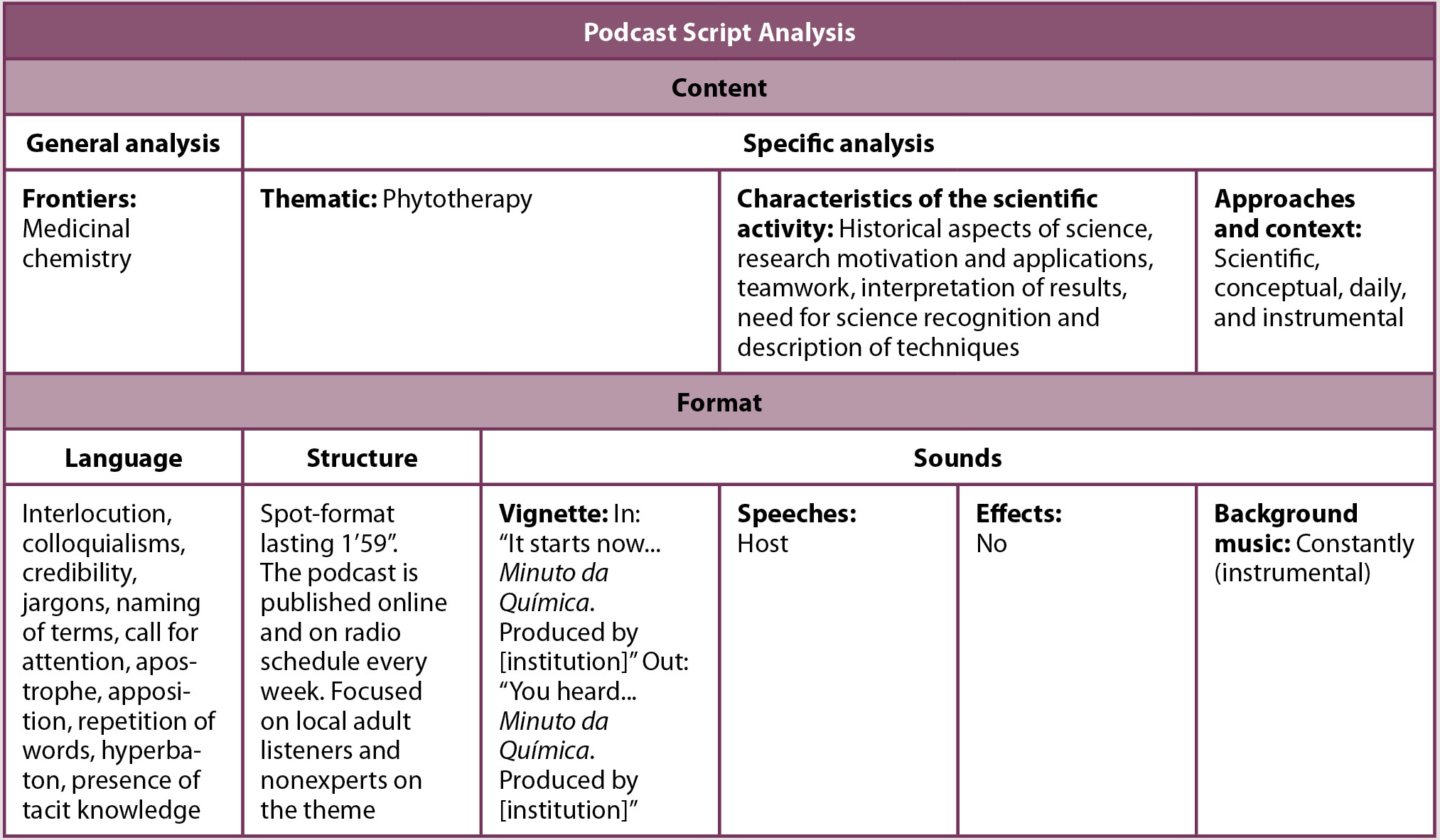
Example of a script analysis: Minuto da Química episode 26 “Phytotherapy.”
In this case, the theme was classified as “frontiers” because it is at the intersection of fields such as chemistry and biology. The characteristics of the scientific activity in the script, such as the historical aspects of science and research applications, reaffirmed its approaches and context: The script is scientific because it is based on studies of medicinal chemistry; it is conceptual because it defines the phytotherapy; it is daily life because the use of plants to treat diseases is common in society; and it is instrumental because it explains techniques for using these plants. Moreover, multiple language features were identified, such as colloquialism, to reinforce the more intimate format of the podcast, and the naming of terms, as the episode mentioned different plants, techniques, and their active principles. Finally, the podcast scripts followed an adequate spot format, which included the use of vignettes, host speech, and background music to signal different segments of the episode. The results obtained for the other episodes were found using a similar analysis.
Content
In a general analysis, the themes most chosen by the students were chemistry (50.8%), frontiers (44.6%), and transversal (23.1%), among which the chemistry of materials (15.4%) and medicinal and environmental chemistry (both 13.8%) stand out, as shown in Figure 4.
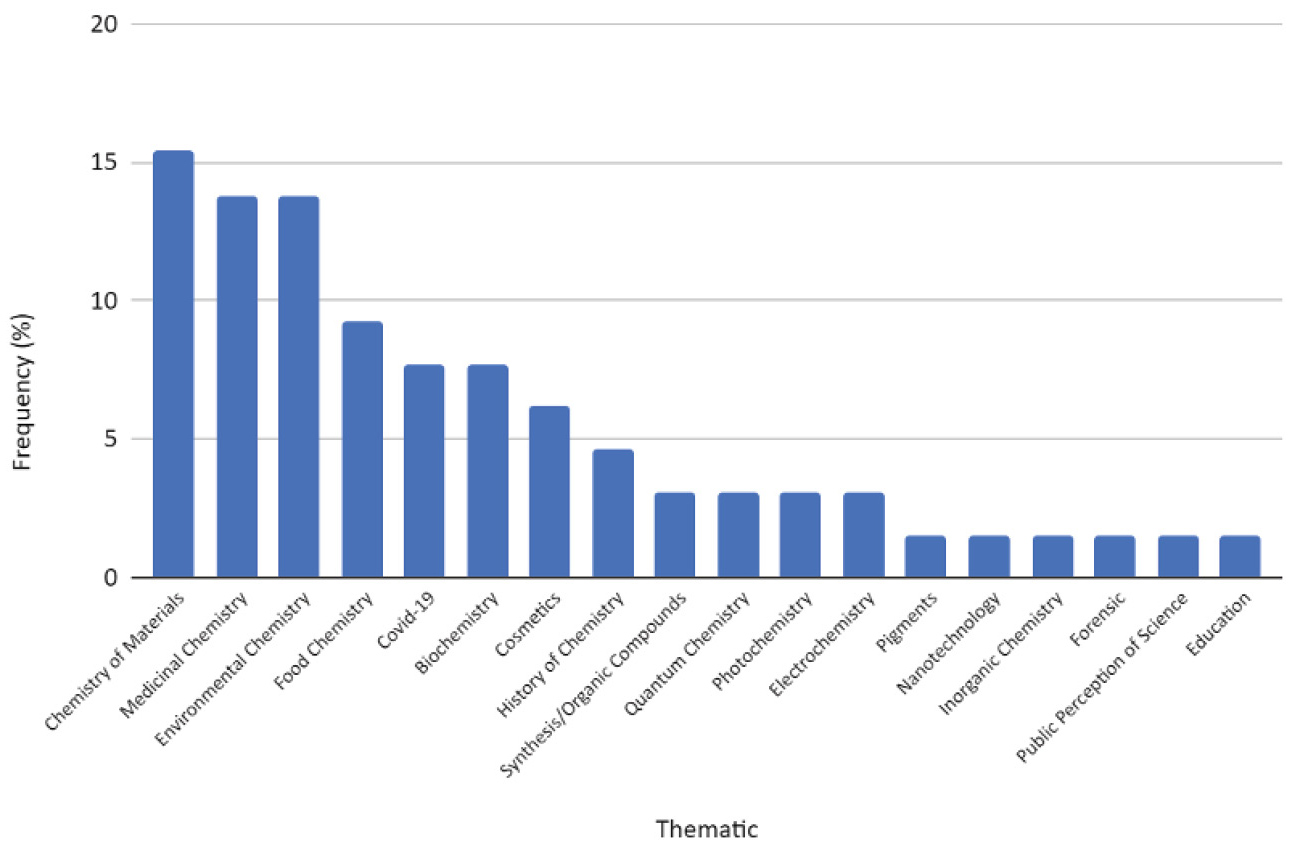
Frequency of themes in the podcast scripts (n = 65).
Among the frontier themes, 55.2% are related to biological areas, corroborating its popularity in science podcasts (MacKenzie, 2019). Along these lines, one can observe a choice of current topics by students. For example, transversal and frontier issues addressing COVID-19 began to be explored due to the widespread dissemination of fake news, which negatively affected the population’s care and protection measures (van der Linden et al., 2020). This same motivation is present in episodes on ephemeris (e.g., Episode 18, which celebrated 150 years of the period table of elements), international treaties (e.g., Episodes 33 through 39, which related to the United Nations 2021 agenda on sustainability), and recent studies (e.g., Episode 31 on the science and technology public perception report). Among the characteristics of scientific activity, the most recurrent themes were research motivations and applications and the description of models, methods, and techniques (see Figure 5).
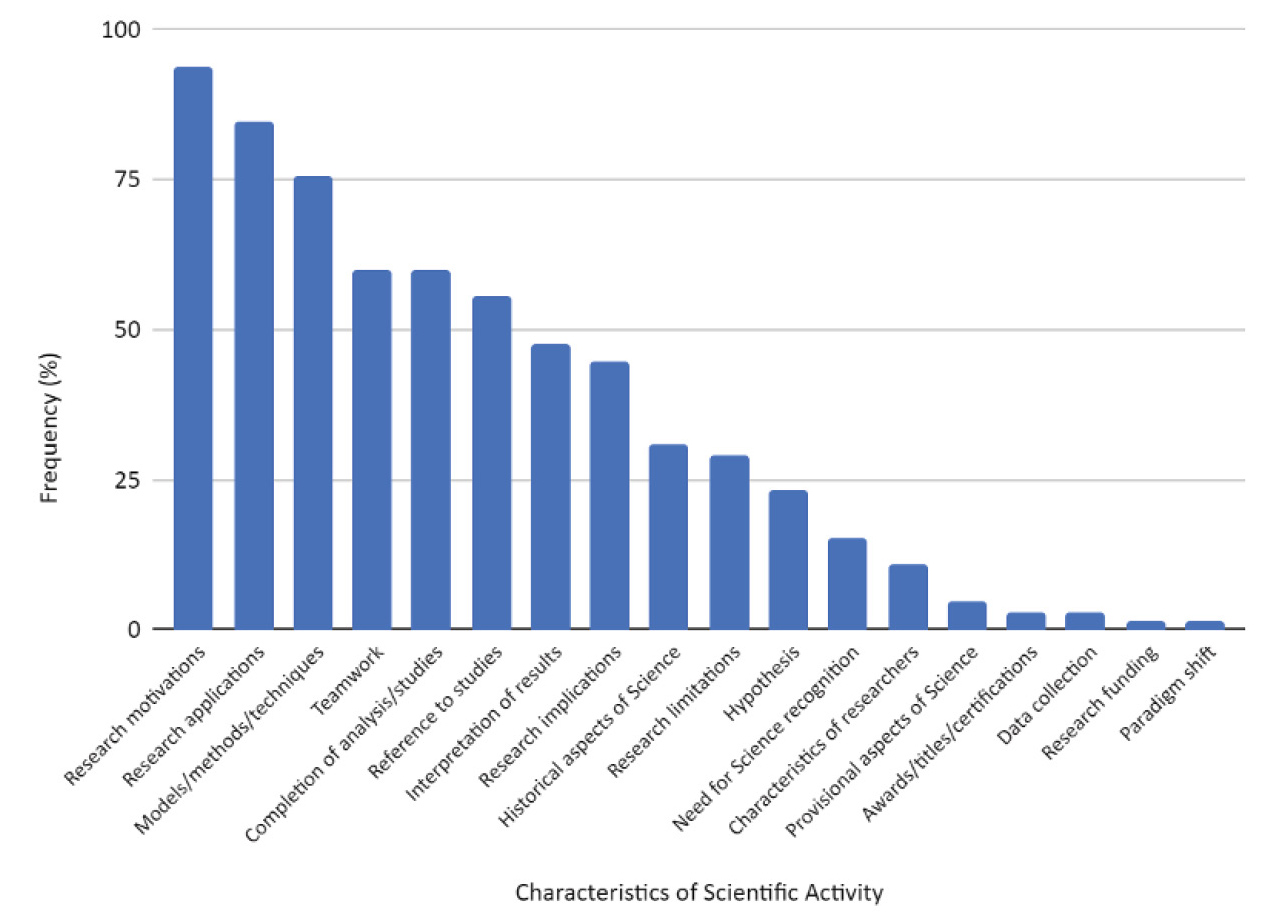
Frequency of scientific activity characteristics in the podcast scripts (n = 65).
These elements are in accordance with the scientific praxis, mainly regarding empirical components such as the description of methods and raising hypotheses; the reflective character of the investigation, present in the interpretation of results; the notion of teamwork, which also reflects the interdisciplinary nature of science; the provisionality manifested in paradigm shifts and research limitations; and the research implications, among which are the historical-social and political issues, that support an undistorted image of scientific activity (Pérez et al., 2001).
The approaches and context were scientific (100.0%), conceptual (98.5%), daily life (63.1%), instrumental (30.8%), technological (24.6%), environmental (18.5%), controversial and historical (both 10.8%), and social and educational (both 1.5%). As expected, scientific, conceptual, and daily aspects were common due to the podcast’s focus and format. Other approaches—such as environmental, instrumental, and polemic—were related to current issues previously discussed.
Format
The frequency of language features is illustrated in Figure 6. Among the most recurrent linguistic features are interlocution and colloquialism (both 100%), found in phrases such as “But I have to say, who hasn’t forgotten to put sunscreen on and got burned after a day at the pool or beach?” (Episode 59). These elements proved to be essential to bring the scientific message closer to listeners, as podcasts facilitate the use of direct dialogue, more personal narratives, and natural voices (Lindgren, 2016; Warhurst et al., 2013). Other resources, such as the call for attention (93.8%), use of quotation marks (29.2%), and phonetic writing (3.1%) indicated orality traits in the scripts (Andrelo, 2013) that are used as a suggestion of the intonation or reading that should be performed by the student-host.
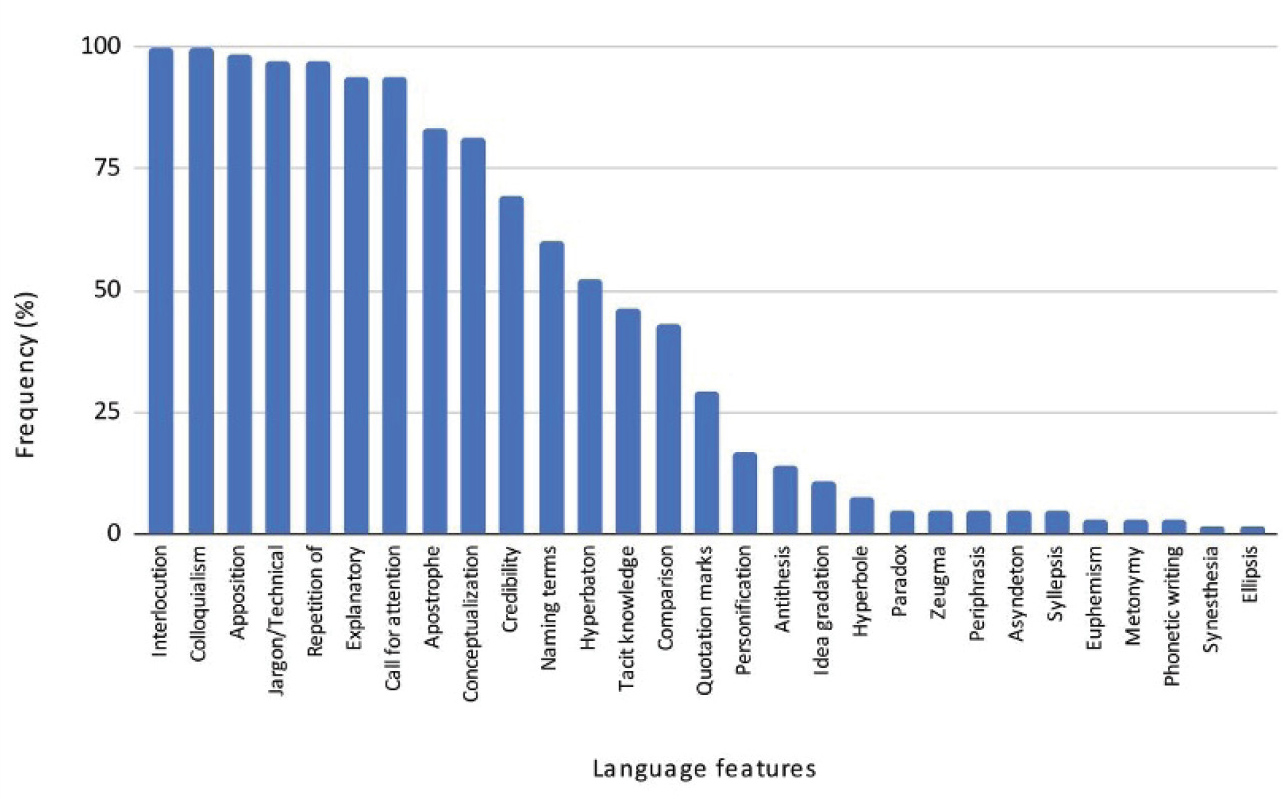
Frequency of language features in the podcast scripts (n = 65).
Elements such as the repetition of words (96.9%) favored the dissemination of the message via radio because the listener cannot “go back” to listen again (McLeish, 2005). This feature is also linked to the frequency of jargon (96.9%), which was recalled and conceptualized recurrently throughout the episodes. However, scripts with less variety in their linguistic features resulted in more conceptual and, consequently, less quotidian approaches.
Because it has a standard identity, the category of sounds had the same specification as in Figure 3 for most episodes, except for Episode 18, in which the message of an interviewed researcher was conveyed at the end of the student-host’s speech. This space was granted due to the guest’s expertise on the subject and his contribution to science at an international level.
Students, listeners, and experts’ perspectives
Figure 7 shows the students’ perceptions on the scripting process. We observed that 71.4% of students disagreed or remained neutral about the statement that undergraduate courses provided prior preparation for practices of this nature. However, after carrying out the activity, 85.7% said they were confident they could produce high-quality scripts. Indeed, scripting podcasts challenges students for a new format and language because it proposes communication beyond peers, but including PCST practices in STEM has shown an increase in students’ confidence and writing skills (Train & Miyamoto, 2017; Tuten & Temesvari, 2013).
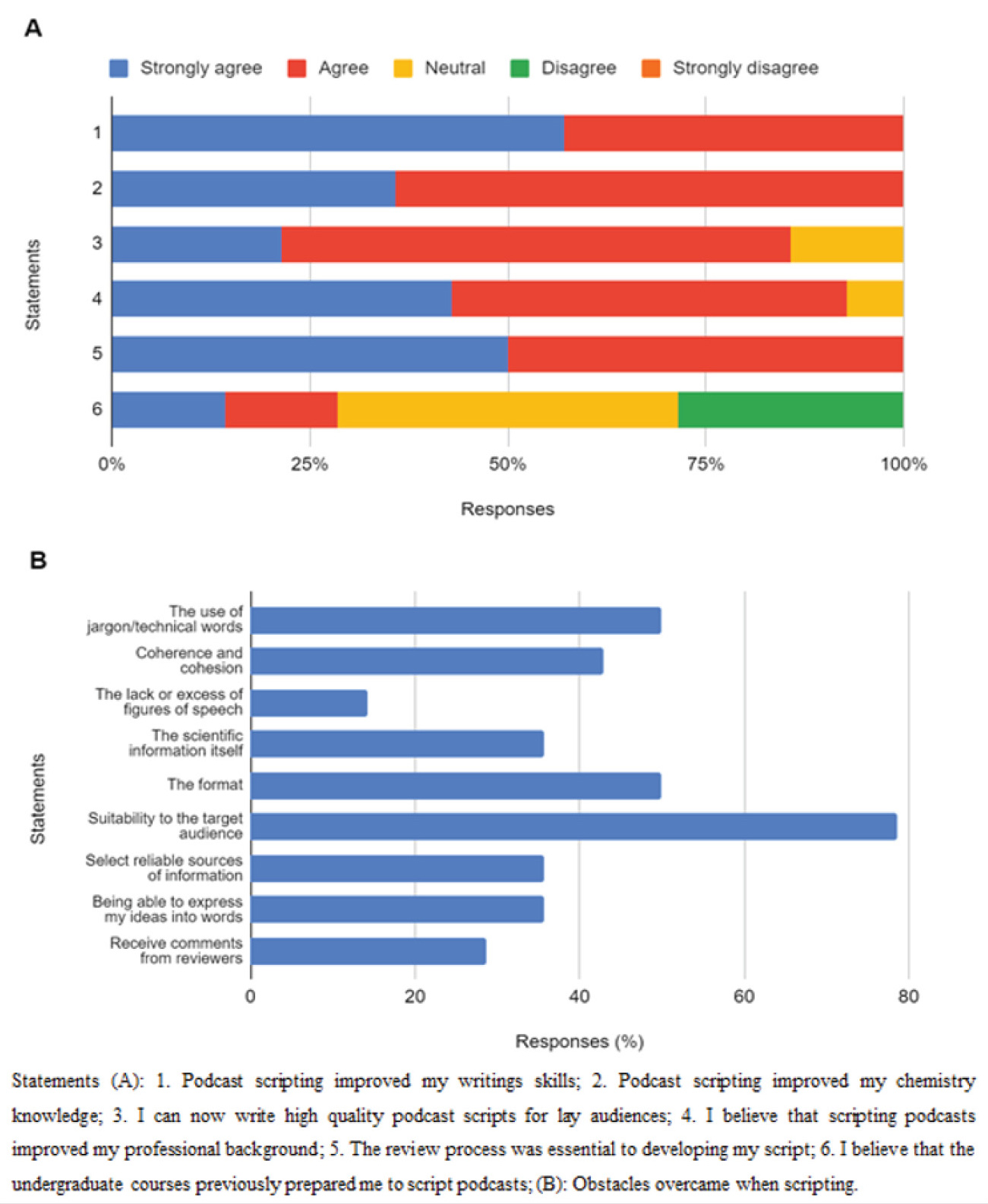
Students’ perceptions of the scripting process.
Note. (A) student responses to the podcast scripting using a Likert scale; (B) obstacles overcome with the activity, in response to a checkbox question (n = 14 questions).
The biggest obstacles overcome by students concern the content suitability for the target audience (78.6%) and the use of jargon (50%). The obstacle to cohesion and coherence is also related to the challenge of transposing ideas onto paper. Throughout history, PCST initiatives in chemistry have dealt with “chemophobia,” mostly linked to the linguistic challenges of making complex subjects suitable (Hartings & Fahy, 2011). Furthermore, science communicators often establish a dogmatic relationship to reproduce the information originally issued by a researcher. One of the ways to fill this gap is with the help of researchers and press officers who know how to communicate effectively with the media and offer more contextual information (Murcott, 2009).
The review process was relevant to all students. According to the literature, the comments not only improve the scientific basis, listed as a challenge for 35.7% of respondents, but also explore the ability to receive feedback and be critical about the work itself (Trautmann, 2009).
These results were compared with listeners’ and experts’ perspectives (see Figure 8). Experts (different from those who reviewed the episodes) were consulted on each theme listed in Figure 4. Frequent and first-time listeners expressed their perceptions about the podcast in general.

Comparison of students’ perspectives with listeners’ and experts’ perspectives.
Note. (A) expert responses to the podcast episodes (n = 21); (B) listener responses to the podcast episodes (n = 31); both used
Likert scales.
As noted, the podcast’s target audience corroborates the overcoming of the challenges listed by the students in Figure 7B when affirming the suitability of the episodes for non-experts. Experts, however, were more reticent about the statements, showing a small percentage of disagreement (4.8%–9.5%), which can be understood as skepticism, as they may assume a questioning position regarding credibility of information in situations where the scientific message is directed to non-experts by other professionals (Dudo, 2015).
Final considerations
Podcast scripting by undergraduate students contributed positively to training future scientists to be capable of communicating science to non-experts. Specifically, students reported overcoming obstacles such as using jargon and making content suitable to the target audience, which was confirmed by most listeners and experts. This activity can be adapted to other contexts and educational levels given the multiplicity of podcast formats and themes, thus contributing to achieving desirable skills in science teaching in the 21st century.
Acknowledgments
We thank the São Paulo Research Foundation (FAPESP, grant 2020/03233-0), the National Council for Scientific and Technological Development (CNPq, grant 304974/2020-0), and the podcast collaborators.
Carolina Sotério (carolina.soterio@usp.br) is a doctoral student, and Salete Linhares Queiroz (salete@iqsc.usp.br) is an associate professor, both at the University of São Paulo in Brazil.
Chemistry Interdisciplinary Literacy New Science Teachers Teaching Strategies Technology


